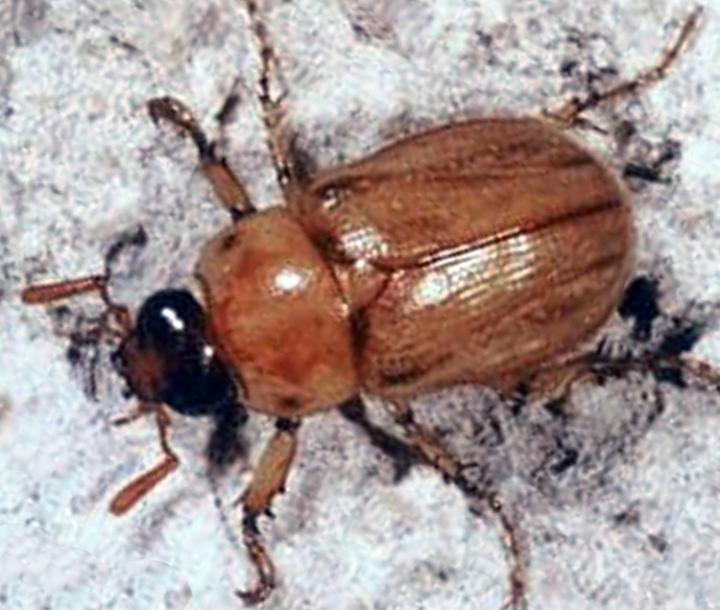Open-access article on masked chafer grubs in turfgrass explains management techniques

Adult masked chafers are small brown beetles (10-15 mm long depending on the species) with a distinctive black stripe or mask across the eyes and face. The one shown here (Cyclocephala pasadenae) is common in the southwestern United States from Texas, western Kansas, and Oklahoma to southern California. Credit: D.C. Lightfoot
Now gardeners, golf-course owners, and growers who have been battling masked chafers for decades have a new resource. An article in the Journal of Integrated Pest Management delves into five of these turfgrass pest species and the options for managing them.
“I became interested in these insects because they are among the hardest grub species to control,” said Sudan Gyawaly, a doctoral student in the Department of Entomology at Virginia Tech University and lead author of the article.
According to Gyawaly, damage from the masked chafer comes from only one life stage.
“The adults of many scarab beetles feed on plants, but adult masked chafers do not. It is the larvae that are the major pests,” he said.
Masked chafer larvae cause their damage by eating the roots of turfgrass. During rainy periods, the grass plants may still be able to send up healthy-looking, green blades, so lawns appear to be doing well. When drier conditions prevail, however, the gnawed-away root system causes the grass to turn brown and die.
High concentrations of white grubs can also draw in insectivores, such as skunks and raccoons, which can cause considerable injury to turfgrass as they excavate the ground in search of the tasty larvae.
Gyawaly is especially interested in biological approaches to reduce grub numbers. This includes the use of entomopathogens, which are organisms that cause disease in insects. He is taking a closer look at the effects of entomopathogenic fungi when paired with chemical insecticides.
“We are getting pretty good results with this approach in the lab, but we aren't getting the results I was expecting in field experiments,” he said. “We need to develop some other techniques to increase the efficacy of using entomopathogenic fungi in the field in combination with insecticide.”
While that work is progressing, he said he hopes this new JIPM paper will provide a good overview of all of the masked chafer species that are major U.S. turfgrass pests.
“We have a good understanding of the biology of the northern and southern masked chafers, and we have book chapters and publications that talk about these two species. But we don't know the biology of C. pasadenae, C. hirta, and C. parallela very well, so they often go ignored,” he said. “That's why I wanted to write this inclusive paper that mentions all of the important species we have in the United States and updates the management information to show how far we have come in terms of their control.”
###
The full article, “Biology, Ecology, and Management of Masked Chafer (Coleoptera: Scarabaeidae) Grubs in Turfgrass” is available at http://jipm.
The Journal of Integrated Pest Management is published by the Entomological Society of America, the largest organization in the world serving the professional and scientific needs of entomologists and people in related disciplines. Founded in 1889, ESA today has more than 7,000 members affiliated with educational institutions, health agencies, private industry, and government. Members are researchers, teachers, extension service personnel, administrators, marketing representatives, research technicians, consultants, students, and hobbyists. For more information, visit http://www.
Media Contact
All latest news from the category: Agricultural and Forestry Science
Newest articles

Silicon Carbide Innovation Alliance to drive industrial-scale semiconductor work
Known for its ability to withstand extreme environments and high voltages, silicon carbide (SiC) is a semiconducting material made up of silicon and carbon atoms arranged into crystals that is…

New SPECT/CT technique shows impressive biomarker identification
…offers increased access for prostate cancer patients. A novel SPECT/CT acquisition method can accurately detect radiopharmaceutical biodistribution in a convenient manner for prostate cancer patients, opening the door for more…

How 3D printers can give robots a soft touch
Soft skin coverings and touch sensors have emerged as a promising feature for robots that are both safer and more intuitive for human interaction, but they are expensive and difficult…





















